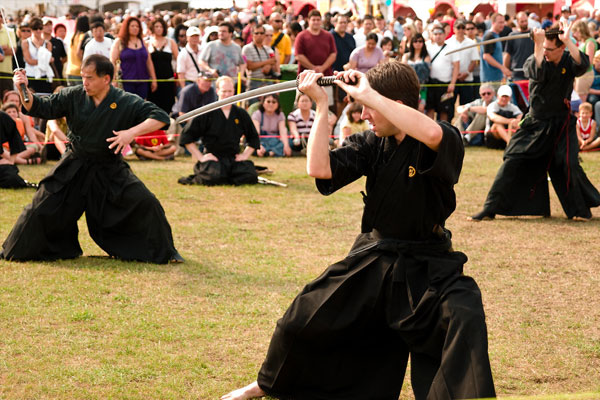Martial Arts Near Me
Kenjutsu
Kenjutsu, the ancient Japanese art of swordsmanship, holds a rich historical significance and serves as the foundation of modern-day martial arts. Originating from the wartime practices of the samurai, Kenjutsu has transformed over centuries, encompassing various styles, techniques, and philosophies. Today, it stands as a testament to Japan's martial heritage and remains an influential art form worldwide.
The history of Kenjutsu dates back to the feudal era of Japan, where samurai warriors emerged as a societal class dedicated to warfare and the service of their lords. With the sword being their primary weapon, the samurai developed and refined martial techniques to ensure their effectiveness on the battlefield. Kenjutsu, meaning "the art of the sword," encompassed a range of combat principles and strategies that aimed to maximize the samurai's ability to prevail over adversaries.
The early development of Kenjutsu was closely associated with the period of continuous civil wars in Japan, known as the Sengoku period (15th-16th century). During this time, various sword schools or "ryu" thrived, each with its own distinctive style and techniques. The grandmasters or "soke" of these schools passed down their knowledge and expertise through generations, resulting in the formation of diverse approaches to swordsmanship.

One notable school is the Tenshin Shoden Katori Shinto Ryu, which claims to be the oldest extant martial arts school in Japan, with a history spanning over 600 years. Another prominent school is the Itto-ryu, founded by Itto Ittosai Kagehisa, renowned for its focus on powerful strikes and precise footwork. These and other sword schools contributed to the development and transmission of Kenjutsu techniques, both across Japan and to future generations.
The techniques of Kenjutsu are diverse and encompass various aspects of swordsmanship. The practice involves both solo and partner drills, focusing on posture, footwork, strikes, blocks, and multiple other techniques aimed at mastering the use of the sword. Stances such as "chudan-no-kamae" (middle position) and "jodan-no-kamae" (high position) are fundamental to Kenjutsu, establishing a solid foundation for executing various strikes and defenses.
Kenjutsu places great importance on distance and timing. Practitioners learn to evaluate the proper distance to engage an opponent and strike with precision, while also maintaining their own defense. Timing is critical, enabling practitioners to anticipate and counter an opponent's attack effectively. These principles of distance and timing lay the groundwork for the concept of "seme," which encompasses psychological and physical strategies to create openings for attacks or defenses.
The techniques of Kenjutsu also emphasize the concept of "ken tai icchi," meaning the unity of sword and body. This concept emphasizes the integration of physical and mental faculties. By cultivating a strong mind-body connection, practitioners are able to wield the sword with fluidity, grace, and control.
Despite significant changes and the declination of the samurai class during the Meiji Restoration in the late 19th century, Kenjutsu managed to survive by evolving into a more accessible and sports-oriented form of swordsmanship. It transitioned from its combative roots to become Kendo, a stylized martial art that introduced a set of rules, protective armor, and a focus on cultivating one's character, rather than solely seeking victory over opponents.
Kendo, which translates to "the way of the sword," holds its roots in Kenjutsu. It transformed Kenjutsu into a modern sport that could be practiced by anyone. Swinging wooden swords or "bokuto," practitioners engaged in rigorous training and friendly contests with a focus on developing discipline, respect, and mental fortitude. The modernization of Kenjutsu into Kendo allowed it to flourish and expand globally while preserving its essence as a martial art.
Today, Kendo stands as a popular martial art practiced worldwide. It has gained recognition and members in many countries, with international competitions and organizations governing its practice. The International Kendo Federation (FIK) provides a global platform for Kendo practitioners, organizing tournaments, setting standards, and promoting cultural exchange related to Kendo.
Kendo's significance extends beyond competitive pursuits. It has become an integral part of educational systems in Japan and is practiced in schools and universities as a means of nurturing discipline, self-control, and a sense of morality. The philosophical aspects of Kendo, such as the cultivation of the virtues of "bushido" (the way of the warrior) and the pursuit of personal improvement, make it an important tool for character development and self-reflection.
In addition to its traditional roots, Kendo has found its place in popular culture. Its stylized techniques, protective armor, and the discipline of the practitioners have been showcased in movies, anime, and other media. Its portrayal in popular culture has further contributed to the dissemination of Kendo practices and philosophies worldwide, capturing the interest of practitioners and enthusiasts alike.
Kenjutsu, the ancient Japanese art of swordsmanship, stands as a testament to Japan's martial heritage. Through its evolution into Kendo, it has become accessible to a larger audience while preserving the principles, techniques, and philosophies of the original martial art form. With a rich history, diverse techniques, and a strong global presence, Kenjutsu and Kendo continue to embody the spirit and essence of the samurai warriors and serve as a means of physical and mental discipline and personal growth.